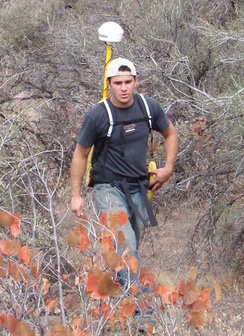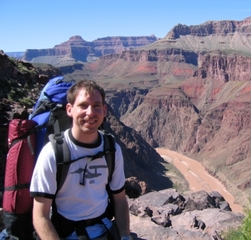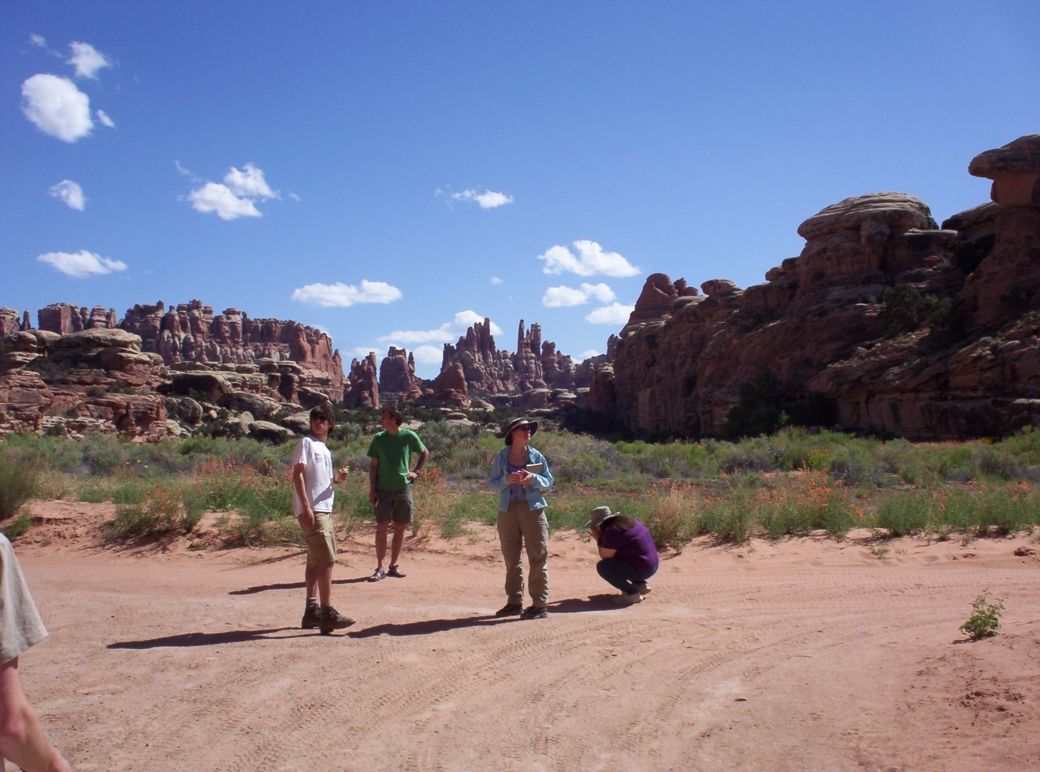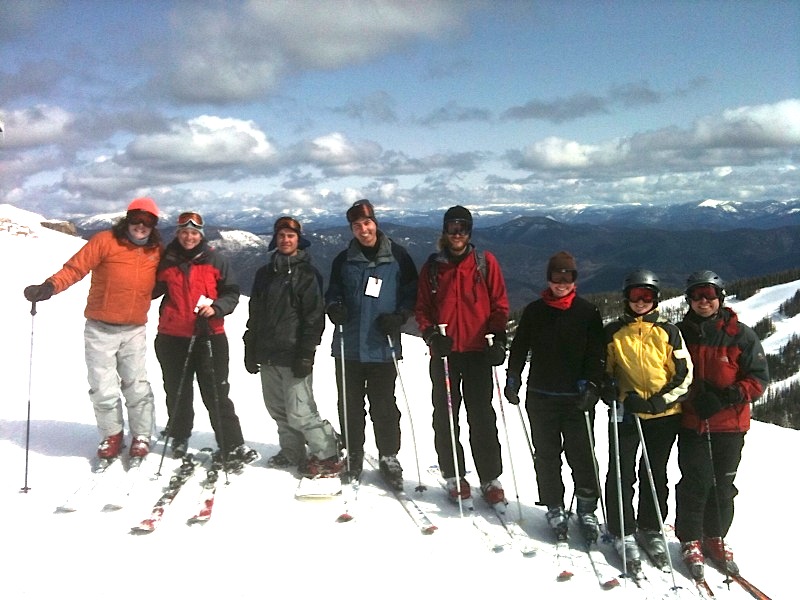Past Graduate Students
(University of Idaho, UI / University of Alaska Anchorage, UAA)
Jane Barnes (MS, 2011, UI)Jane received her BS from Hamilton College, New York, in 2009. Her MS research considered the internal deformation of subglacially erupted hyaloclastite ridges along the plate boundary of Iceland. These ridges can deform under their own weight by gravitational slumping, through the intrusion of magmatic dikes, through the injection of overpressured fluids, and by long-term tectonic stress across the plate boundary. Much of this deformation occurs through the formation of cataclastic deformation bands, which were initially described in Iceland by our collaborator, Barb Tewksbury (Hamilton College, New York). The results of this work are currently being prepared for submission to the Journal of Structural Geology. Jane is currently living in Duanesburg, New York, where she is undoubtedly amusing the locals.
Thesis: Deformation bands in subglacially erupted hyaloclastite ridges, Reykjanes Peninsula, Iceland. |
Sandi Billings (MS, 2004, UI)Sandi completed her MS degree in geophysics at the University of Idaho in 2004 after completing a BS in Florida. Her research was aimed at estimating the thickness of the brittle or elastic portion of the ice shell of Jupiter's moon, Europa. She also examined evidence for potential large-scale impact features on Europa that may have led to the development of a type of feature called chaos. The results of her research were published in the October 2005 volume of the journal Icarus (Special Volume on Europa's Icy Shell). Sandi is currently living in Moscow, Idaho. She previously served on the board of directors for the Pacific section of the American Astronomical Union.
Thesis: Analysis of the ice shell of Jupiter's moon, Europa: Estimation of ice thickness and an examination of impact effects into a floating ice shell. |
Matt Blakeslee (MS, 2012, UI)Matt completed his BS degree at the University of Idaho in 2010. Matt's MS research examined the evolution of segmented normal fault systems, with an emphasis on relay ramp evolution and its effect on the partitioning of slip along segmented normal faults as the segments progressively grow. In addition to a numerical modeling analysis of controls on relay ramp geometry, Matt also examined relay ramps in the field in California, Utah, and Nevada. Matt also considered the earthquake history and seismic hazard potential of the Hat Creek fault in northern California. The results of his research were published in the journal Geosphere in 2013, with a second paper accepted for publication in AAPG Bulletin in 2016. Matt currently lives in Anchorage, Alaska, where he works in the geotechnical field.
Thesis: Segmented normal fault evolution: interpretation of relay zone deformation and seismic hazard analysis. |
Nate Boersma (MS, 2006, UI)Nate completed his BS degree at Grand Valley State University, Michigan, in 2004. Nate's MS research focused on the relationship between normal faulting and surface folding in southwest Iceland. He developed a conceptual and numerical model to explain the evolution of a monocline above an active subsurface fault and determined a mechanism for inferring subsurface fault geometry and evolution based on spatially variable monocline characteristics. Nate is currently located Houston, Texas, working as a geologist for the Hess Corporation, an energy resource company.
Thesis: Surface monocline development above normal faults in basalt: numerical models and observations from southwest Iceland. |
June Clevy (PhD, 2014, UI)June completed her BS degree at Illinois State University in Normal, IL, in 2003. June's research investigated the surface characteristics of Arabia Terra in the equatorial western hemisphere of Mars, mapping out evidence of past water concentrations on Mars using epithermal neutron data from the Mars Odyssey spacecraft (used to determine water-equivalent hydrogen concentrations, or WEH) as well as surface evidence of ancient drainages. She also examined how topography may have ultimately impacted WEH concentrations and evidence for seasonal variability in the WEH concentration on Mars. June currently lives in Moscow, Idaho, where she works for the University of Idaho.
Dissertation: Geospatial analysis and seasonal changes in water-equivalent hydrogen in eastern equatorial Mars. |
Christina Coulter (MS, 2009, UI)Christina received her BS degree from Michigan Tech. Her MS research examined the processes responsible for the creation of ridges on Europa. Although these features are ubiquitous, their origins have been elusive. Christina discovered that a combination of processes, involving dilation, shearing, and contraction can contribute to the formation of ridges, but that some amount of shearing is always a necessary component. She also discovered that the topographic variability and evolution of ridges involves visco-plastic collapse of ridges, requiring a source of heat nearby, ostensibly resulting from shearing. Christina currently lives in rural Alaska, where she works as an independent consultant.
Thesis: Kinematic and morphological evolution of Europa's ridges. |
Rachel Daly (MS, 2010, UI)Rachel Daly (now Rachel Hobbs) completed her BS at Colby College, Maine, in 2008. Her MS research considered the decades-old enigma of the origin of Upheaval Dome in Utah. Recent work has provided convincing evidence that the feature was caused by meteorite impact during the Cretaceous and now forms the deeply eroded root of that ancient impact feature. This evidence has been used to refute the alternative origin hypothesis that invokes salt diapirism to explain the feature. Rachel's detailed examination of a range of deformation styles at Upheaval Dome revealed that although there is ample deformation evidence of a dynamic event (meteorite impact), this deformation is superposed by a later, long-lived period of deformation that we interpret to be the result of impact-induced diapirism. Hence, both hypotheses for the origin of the dome are technically correct. Rachel works as a geologist in Albuquerque, NM.
Thesis: Fracture styles at Upheaval Dome, Canyonlands National Park, Utah, imply both meteorite impact and salt diapirism. |
Leslie Fernandes (MS, 2005, UI)Leslie received a BS degree from Castleton University, Vermont, in 2003. His MS research examined evidence for temporal strain partitioning on the Reykjanes Peninsula, Iceland, through a detailed mapping survey and analysis of faulting and fracturing patterns in this oblique spreading environment. He performed an exhaustive search for clues in the fracture history to indicate the importance of the magmatic cycle on the structural architecture of the region. Leslie is currently living and working in Vermont.
Thesis: The magmatic influence on temporal strain partitioning at an oblique spreading center, southwest Iceland. |
James Grant (MS, 2002, UI)Jim received a BS degree from Hamilton College in 2000. His MS research integrated detailed field observations and numerical model predictions to examine the mechanics and evolution of normal fault systems and fracture swarms in southwest Iceland. This work was published in the March 2003 volume of the Journal of Structural Geology. Jim works at Chesapeake Energy in Oklahoma City, Oklahoma.
Thesis: Normal fault evolution at an extensional plate boundary, southwest Iceland: A field and numerical modeling investigation. |
Julie Groenleer (MS, 2006, UI)Julie received her BS degree from Grand Valley State University, Michigan, in 2004. Her MS research examined the growth of curved cycloidal cracks on Jupiter's moon Europa. She utilized mathematical models based on linear elastic fracture mechanics in tandem with calculated tidal stress states in Europa's ice shell to develop a mechanical model for the development of cycloid cusps in a manner analogous to shearing-induced tailcracks along strike-slip faults. She thus showed that shearing deformation is a major aspect of the tectonics on Europa. This work was published in the journal Icarus in 2008. Julie is currently works as an environmental geologist in Livonia, Michigan.
Thesis: Analysis of cycloid growth models for Jupiter's moon, Europa: implications from developmental history and mathematical modeling. |
Jonathan Kay (MS, 2010, UI)Jon received a BA degree from Wheaton College, Massachusetts, in 2008. His MS research emphasized the geologically most-recent tectonic features on the surface of Europa's icy shell. These fractures, called troughs, crosscut all other tectonic features, as well as features that appear to have formed through some sort of endogenic process in a thickening ice shell that created disrupted regions called chaos at the surface. Jon produced maps of young troughs, then calculated the contemporary stress fields that would exist on the surface in response to tidal forcing and the process of nonsynchronous rotation of the ice shell. By comparing fracture patterns to these stress fields, Jon was able to make a case that some regions contain fractures that may have formed within the past few tens of thousands of years, implying a potentially tectonically active ice shell.
Thesis: The case for recent tectonic activity on Jupiter's moon Europa. |
Scott Marshall (MS, 2004, UI)Scott received his BS degree from Wright State University, Ohio, in 2002. His MS research involved an investigation of strike-slip faults and related secondary fractures on Jupiter's moon Europa, complemented by comparisons to similar features seen on Earth. His terrestrial based work was centered near Lake Mead, southeastern Nevada, where he mapped large-scale strike-slip faults in the Lake Mead fault system as well as small-scale deformation band faults and slipped joints in Valley of Fire State Park. This work resulted in three journal articles, in Icarus (2005), Journal of Structural Geology (2006), and a GSA Special Paper (2010). Scott completed his PhD degree under Dr Michele Cooke at the University of Massachusetts at Amherst, and is now a professor at Appalachian State University in Boone, North Carolina.
Thesis: The case for recent tectonic activity on Jupiter's moon Europa. |
Emily Martin (PhD, 2014, UI)Emily received a BA degree in physics at Wheaton College, Massachusetts, in 2006 and an MS degree in Earth and Planetary Sciences at Northwestern University, Illinois, in 2009. Emily's PhD research investigated fracture development on Enceladus, in an attempt to unravel the underlying driving mechanisms for the wide range of tectonic features visible on the surface. Emily determined that the ancient cratered terrains have recently begun tectonic dissection by fractures called pit chains, with a range of orientations that suggest development in response to faster-than-synchronous rotation of the ice shell relative to the solid interior. These observations agree with recent work (such as that by fellow graduate student at the University of Idaho, Alex Patthoff) that the ice shell of Enceladus is underlain by a global ocean. Emily has also mapped the global distribution of strike-slip faults on Enceladus (which do not appear to be related to nonsynchronous rotation) and examined the role of craters in controlling nearby fracture growth paths within crater-perturbed stress fields. Emily currently lives in Washington DC, where she works as a researcher at the Smithsonian Institution's National Air and Space Museum Center for Earth and Planetary Studies.
Dissertation: The fractured ice shell of Saturn’s moon Enceladus: Insights into the global stress history and interior structure. |
Amelia McMillin (MS, 2013, UI)Amy received her BS degree in geology from Western State Colorado University, in 2011. Her MS research examined the geometry of segments, linkages, and overlaps in normal fault systems on the flanks of Alba Patera, Mars, for comparison with terrestrial fault systems. Mars offers unrestricted views of segmented normal fault geometries that allow the creation of extensive data sets on fault geometric characteristics, allowing Amy to examine predictive geometric constraints on the breaching likelihood of normal fault relay ramps. Amy currently resides in Seattle, Washington, where she works as a geologist.
Thesis: Assessment of linkage likelihood in segmented normal fault systems in the Tharsis region, Mars. |
James Muirhead (PhD, 2016, UI)James completed BS and MS degrees in geology at the University of Auckland, New Zealand in 2010. His PhD research is characterizing the spatial and temporal partitioning of strain by faulting and magmatism during the early stages of continental rifting, focusing on the eastern rift of the East African Rift system in Tanzania and Kenya. James has mapped faults within the Natron and Magadi basins in an attempt to determine patterns of fault strain through time and its relationship to underlying magmatic activity and the evolution of the border fault system. He has also examined the manner in which eruptive activity through dikes evolves during early rifting, including the competing roles of regional versus local stresses on dike emplacement (published in Geochemistry Geophysics Geosystems in 2015). In collaboration with geoscientists at the University of New Mexico and the University of Rochester, he also investigated the role of faults in transporting deep carbon to the surface, having an significant impact on the previously estimated global CO2 budget from natural sources (in press in Nature Geoscience as of November 2015). James is currently a faculty member at the University of Auckland, New Zealand.
Dissertation: Tectonic-magmatic controls on volcanism, rifting, and volatile release. |
D. Alex Patthoff (PhD, 2013, UI)Alex received a BS from Virginia Tech and an MS degree from West Virginia University. His PhD research considered the fracturing of ice in the south-polar region of Saturn's moon Enceladus to: (1) establish the stress history recorded in the fracture sequence, (2) determine the properties of the ice shell, and (3) provide insights into the eruptive plumes emanating from cracks in this region. In so doing, Alex discovered that the pattern of fractures in the south polar region is consistent with the stresses caused by faster-than-synchronous rotation of the ice shell relative to the solid interior, suggesting the ice shell is decoupled by an underlying liquid layer. This work was thus the first to show indirect evidence that Enceladus has a global ocean; since confirmed by spacecraft observations in 2015. The work was published in Geophysical Research Letters in 2011, for which Alex received the nationally competitive 2012 Pellas-Ryder Award from the Geological Society of America and the Meteoritical Society for the best student-first-authored paper in planetary sciences during 2011. After working as a postdoctoral researcher in planetary science at the Jet Propulsion Laboratory in Pasadena, California, under the mentorship of Dr. Robert Pappalardo (lead scientist of NASA's Europa Clipper mission), Alex settled in southern California and works as a geology instructor and a planetary science researcher.
Dissertation: Tectonic history of the South Polar Terrain of Saturn's moon Enceladus and evidence for a global ocean. |
Suzette Payne (PhD, 2011, UI)Suzette's PhD research used recent GPS data from the Snake River Plain and adjacent Centennial Tectonic Belt (part of the Basin and Range Province north of the Snake River Plain) to infer a velocity differential from the CTB to the SRP that can only be reconciled with the presence of right-lateral shearing between the two provinces at a rate of ~0.7 mm/yr. This shearing is not taken up by a discrete boundary between the two provinces but is rather likely distributed between numerous preexisting structural features (faults). The results of her research were published in the August 2008 volume of the journal Geology, with additional articles in 2012 in Geophysical Journal International, and in 2013 in Lithosphere. Suzette is currently living in Idaho Falls, Idaho, and works for the Idaho National Laboratory as a seismologist.
Dissertation: Kinematics of the Snake River Plain and Centennial Shear Zone, Idaho, from GPS and earthquake data. |
Matthew Pendleton (MS, 2015, UI)Matthew received a BS degree in geology from the University of Minnesota in 2011. Matt's MS research unraveled the structural, volcanic, and water-flood/mudflow history along a large dike intrusion complex called the Cerberus Fossae, near the Elysium Mons volcano, Mars. Matt's work revealed that the development of these deep fissure systems involves precursor dike intrusions that cause an elongate zone of melting and subsidence at surface, immediately above the dikes. The dikes ultimately breach the surface through these elongate depressions and form lava pools that may ultimately breach the depression edges and flow out down the regional slope. Melting of subsurface ice during dike intrusion also results in the flow of water across the surface, or within surface sediments, resulting in advection of surface materials through valleys and drainage systems. Ongoing hydrothermal activity after the development of fissures may indicate surface seeps and hot spring along the fissure margins that may be important habitable environments if microbial life exists on Mars. Matt spent several years in Los Angeles, California, where he worked as a staff geologist and is now a PhD student at the University of Waterloo, Canada.
Thesis: Geomorphic evidence for geologically recent groundwater flow associated with the Cerberus Fossae magmatic and volcanic system, Mars. |
Conrad Schaefer (MS, 2002, UI)Conrad received a BS degree in geology from the University of Delaware in 2000. His MS research considered the cooling history and resultant fracture growth evolution in small pahoehoe lava flows of the Eastern Snake River Plain, Idaho. Conrad developed a fracture classification scheme for the basalt flows and also developed the first numerical models to consider both conduction and convection cooling in finite flows. The results of his field-based research were published in the March/April 2004 volume of the Bulletin of the Geological Society of America. A second paper was published the Journal of Volcanology and Geothermal Research in 2008, showcasing his numerical modeling of lava flow cooling.
Thesis: Field characterization and thermal-mechanical analysis of fracture distributions in basalt lava flows, Eastern Snake River Plain, Idaho. |
Justin Vetter (MS, 2005, UI)Justin received a BS degree in geology from Western Michigan University in 2003. His MS research examined evidence for ridge development through the combination of shearing and contractional deformation mechanisms on Jupiter's icy moon Europa. Justin utilized a geometric technique for determining ridge kinematics by considering the amounts of strike-separation of offset features relative to their intersection angles. The work demonstrated that ridges, the most ubiquitous feature on Europa, cannot be explained purely through mechanisms of dilation. Justin currently resides in Seattle, Washington, where he is employed as a geoscientist.
Thesis: Evaluating displacements along Europan ridges. |
Erin Walker (MS, 2008, UI)Erin's MS research involved a structural analysis of the Hat Creek fault zone in northern California to unravel the growth evolution and slip characteristics of the fault as it broke through Pleistocene lava flows. Her detailed mapping of the fault using aerial photographs and digital elevation models (DEM) supplied by the United States Geological Survey, combined with field mapping and sampling, allowed her to develop the most detailed story to date on the throw characteristics of the fault and its evolution in response to changing stress fields and nearby magmatic systems. The work has been accepted for publication in AAPG Bulletin in a special volume to be released in 2016. Erin currently resides in Pittsburgh, PA.
Thesis: Evolution of the Hat Creek fault system, northern California. |
University of Idaho graduate research group in a 2004 photo in the Grabens of Canyonlands National Park, Utah. L to R: Scott Marshall, Sandi Billings, June Clevy (back), Simon Kattenhorn, Justin Vetter, Leslie Fernandes (back), Nate Boersma.
University of Idaho graduate research group in a 2004 photo in the Island in the Sky district of Canyonlands National Park, Utah. L to R: Scott Marshall, Sandi Billings, Nate Boersma, June Clevy, Simon Kattenhorn, Leslie Fernandes, Justin Vetter.
Geomechanics research group field trip to SE Utah, May 2004. There seems to be some confusion about what we're supposed to be looking at...
Geomechanics research group annual ski weekend retreat, April 2010. L to R: Jane Barnes, Emily Martin, Matt Blakeslee, Simon Kattenhorn, Kevin Hobbs (friend of geomech), Rachel Daly (now Rachel Hobbs), Abby Patthoff (friend of geomech), Alex Patthoff.
Alex Patthoff and Simon Kattenhorn in a 2011 university press article describing our work on the discovery of evidence for a global ocean on Saturn's moon Enceladus.


























